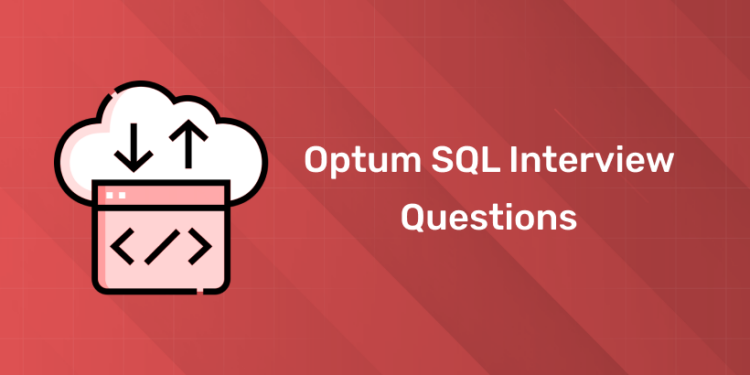Table of Contents
Optum, a leading health services and innovation company under UnitedHealth Group, leverages data and technology to enhance healthcare delivery and outcomes. In this blog, we will explore some of the most common and technical SQL interview questions that candidates may encounter during an Optum interview. These questions will cover SQL fundamentals, advanced query techniques, database optimization, and real-world problem-solving scenarios, helping you prepare for your interview and demonstrate your expertise in managing healthcare data efficiently.
Learn Full Stack Development with expert mentors! Get Free Demo Here!
Introduction
Optum, a subsidiary of UnitedHealth Group, is a leading healthcare services and innovation company that combines advanced technology, data analytics, and clinical expertise to improve healthcare delivery and outcomes. With a global presence and operations in over 150 countries, Optum focuses on providing integrated healthcare solutions through its core divisions: OptumHealth, OptumInsight, and OptumRx.
The company is at the forefront of using artificial intelligence, big data, and telemedicine to enhance care delivery, reduce costs, and improve patient outcomes. Known for its innovative approach and commitment to value-based care, Optum plays a pivotal role in transforming the healthcare industry, making it an attractive choice for professionals seeking to contribute to impactful, technology-driven healthcare solutions.
Why Join in Optum?
Joining Optum can be an attractive option for professionals in the healthcare and technology sectors for several reasons. Here are some key benefits of working at Optum:
1. Impactful Work in Healthcare Innovation
- Healthcare Focus: Optum is part of UnitedHealth Group, one of the largest healthcare companies globally. Working at Optum allows you to contribute to innovative healthcare solutions that impact millions of lives.
- Data-Driven Healthcare: Optum uses advanced data analytics, machine learning, and AI to improve healthcare outcomes and reduce costs, making it a great place for data professionals to apply their skills in a meaningful way.
2. Career Growth and Learning Opportunities
- Continuous Learning: Optum encourages professional development and provides access to training and upskilling programs in technology, data science, healthcare management, and more.
- Diverse Career Paths: With opportunities across technology, healthcare, business, and operations, Optum offers a diverse set of roles, allowing for growth and cross-functional learning.
3. Technology-Driven Organization
- Cutting-Edge Technology: Optum leverages cutting-edge technology like cloud computing, AI, machine learning, and big data to create healthcare solutions. This provides tech professionals with exciting opportunities to work on innovative projects.
- Tech Transformation: Optum’s focus on digital transformation in healthcare offers software developers, data scientists, and other technical professionals the chance to work in a dynamic and forward-thinking environment.
4. Global Presence and Collaborative Culture
- International Reach: Optum operates in multiple countries, offering the chance to work with diverse teams and gain international experience. This global presence opens up opportunities for both personal and professional growth.
- Collaborative Environment: Optum fosters a collaborative work culture where cross-functional teams work together to create integrated solutions that improve healthcare delivery.
5. Focus on Employee Well-Being
- Work-Life Balance: Optum promotes a healthy work-life balance with flexible working options, remote work opportunities, and wellness programs.
- Comprehensive Benefits: Optum provides a wide range of employee benefits, including healthcare, retirement plans, and wellness programs designed to support both physical and mental health.
6. Commitment to Social Responsibility
- Corporate Social Responsibility: Optum is dedicated to improving the communities it serves, with a focus on making healthcare affordable and accessible. Employees often participate in initiatives that contribute to better health outcomes and community welfare.
- Sustainability: Optum has a strong focus on sustainability and reducing its environmental footprint, aligning its operations with ethical practices.
7. Innovative Projects and Challenges
- Challenging Work: Optum presents professionals with challenging problems to solve, whether in healthcare technology, claims management, or analytics. This fosters a stimulating work environment where you can make significant contributions.
- Research and Development: For those interested in research, Optum offers opportunities to engage in the development of new healthcare models, research studies, and data-driven healthcare innovation.
8. Diverse and Inclusive Workplace
- Inclusive Culture: Optum is committed to diversity and inclusion, fostering a workplace that celebrates differences and values diverse perspectives. It actively supports various employee resource groups and diversity initiatives.
- Equal Opportunities: With a focus on equal employment opportunities, Optum supports a culture of respect, providing employees with opportunities regardless of background or experience.
9. Strong Financial Stability
- Part of UnitedHealth Group: Being part of UnitedHealth Group, Optum offers the stability of a Fortune 500 company with the innovation of a technology-driven organization. This provides job security and growth opportunities.
10. Competitive Compensation
- Attractive Salary Packages: Optum offers competitive salaries and benefits, making it an appealing option for both entry-level and experienced professionals.
- Bonus and Incentives: Employees are often rewarded with performance-based bonuses, stock options, and other incentives, motivating individuals to strive for excellence.
Optum Interview Preparation Tips for SQL
Preparing for an SQL interview with Optum requires a strategic approach, as they expect candidates to demonstrate both technical proficiency and problem-solving skills. Below are some SQL interview preparation tips tailored for Optum:
1. Understand SQL Fundamentals Thoroughly
- Ensure that you have a solid understanding of SQL basics such as
SELECT,INSERT,UPDATE,DELETE,WHERE,GROUP BY,ORDER BY, etc. - Revise concepts like joins (inner, left, right, full), set operations (
UNION,INTERSECT), and subqueries (correlated and non-correlated).
2. Master Advanced SQL Concepts
- Be familiar with window functions (
ROW_NUMBER(),RANK(),DENSE_RANK(),LEAD(),LAG()), as these are commonly asked in interviews. - Learn about Common Table Expressions (CTEs), temporary tables, and derived tables.
- Study aggregate functions like
SUM(),COUNT(),AVG(),MIN(),MAX()along with grouping data (GROUP BYandHAVING).
3. Prepare for Database Design and Normalization Questions
- Be ready to explain normalization (1NF, 2NF, 3NF, BCNF) and why it’s essential for minimizing redundancy and ensuring data integrity.
- Practice designing efficient database schemas and explaining relationships like one-to-one, one-to-many, and many-to-many.
4. Learn SQL Query Optimization Techniques
- Understand how to write efficient queries and how to optimize them for performance using indexes, execution plans, and reducing the use of nested queries.
- Be familiar with indexing strategies (clustered vs non-clustered indexes) and how they impact performance.
5. Hands-on Practice with SQL Queries
- Optum will likely focus on real-world problem-solving scenarios. Practice writing complex queries involving JOINS, subqueries, and window functions.
- Websites like LeetCode, HackerRank, and SQLZoo offer SQL challenges that can help you practice and improve query-writing skills.
6. Brush up on Transactions and ACID Properties
- Understand transactions, commit, rollback, and how they ensure data integrity.
- Review the ACID properties (Atomicity, Consistency, Isolation, Durability) and how they are applied in database transactions.
7. Be Prepared for Case Scenarios
- Optum interviews may include business case scenarios where you need to query a sample database to retrieve specific data or perform analysis. Make sure you can translate business requirements into efficient SQL queries.
8. Understand Data Modeling and ETL Concepts
- Be familiar with data modeling, the use of primary keys, foreign keys, and constraints.
- If the role involves data analysis, understand basic ETL (Extract, Transform, Load) concepts and how SQL is used for data transformation.
9. Work with Stored Procedures, Triggers, and Functions
- Be comfortable with creating and using stored procedures, triggers, and user-defined functions.
- Understand how triggers can automate tasks and maintain database integrity.
10. Get Familiar with Database Management Systems (DBMS)
- Be aware of the specific DBMS Optum uses (e.g., SQL Server, MySQL, Oracle, PostgreSQL) and practice SQL in that environment.
- Learn how to create, modify, and manage database objects like tables, views, and indexes.
Learn Full Stack Development with expert mentors! Get Free Demo Here!
Top Optum SQL Interview Questions and Answers
Basic SQL Questions:
1. What is SQL?
Answer: SQL (Structured Query Language) is a domain-specific language used for managing and manipulating relational databases. It is used to query, update, and manage data in a database system.
2. What is the difference between DELETE and TRUNCATE?
Answer: DELETE removes rows based on a condition and can be rolled back, while TRUNCATE removes all rows in a table without using a condition and cannot be rolled back.
3. What are the different types of SQL joins?
Answer:
- INNER JOIN: Returns rows that have matching values in both tables.
- LEFT (OUTER) JOIN: Returns all rows from the left table, and the matched rows from the right table.
- RIGHT (OUTER) JOIN: Returns all rows from the right table, and the matched rows from the left table.
- FULL (OUTER) JOIN: Returns rows when there is a match in one of the tables.
4. Explain the concept of normalization.
Answer: Normalization is the process of organizing data to reduce redundancy and improve data integrity. It involves dividing a database into tables and establishing relationships between them. Common forms include 1NF, 2NF, and 3NF.
5. What is a primary key?
Answer: A primary key is a unique identifier for a record in a table. It must contain unique values and cannot contain NULL values.
6. What is a foreign key?
Answer: A foreign key is a column or a set of columns in one table that references the primary key of another table. It establishes a relationship between the two tables.
7. What is an index in SQL?
Answer: An index is used to speed up the retrieval of rows from a table by creating a quick lookup for data. Indexes can be created on one or more columns of a table.
8. What is a view in SQL?
Answer: A view is a virtual table that is based on the result of a SQL query. Views do not store data themselves but provide a way to simplify complex queries.
9. What is the GROUP BY clause used for?
Answer: The GROUP BY clause is used to group rows that have the same values in specified columns. It is often used with aggregate functions like COUNT(), SUM(), AVG(), etc.
10. What is a subquery in SQL?
Answer: A subquery is a query nested inside another query. Subqueries can be used in SELECT, INSERT, UPDATE, or DELETE statements.
Intermediate SQL Questions:
11. What is the difference between WHERE and HAVING?
Answer: WHERE is used to filter rows before grouping, while HAVING is used to filter rows after grouping has been applied.
12. Explain the use of UNION and UNION ALL.
Answer: UNION combines the results of two or more queries and removes duplicate rows, while UNION ALL combines the results and retains all duplicate rows.
13. What is a stored procedure?
Answer: A stored procedure is a precompiled collection of SQL statements that can be executed as a program. It helps in reusability and improves performance by reducing the need for repeated compilation.
14. What are triggers in SQL?
Answer: Triggers are automatically executed when specific events occur in a table (e.g., INSERT, UPDATE, or DELETE). They are used to enforce business rules, audit changes, or replicate data.
15. What is the difference between CHAR and VARCHAR?
Answer: CHAR is a fixed-length data type that always reserves the same amount of space, while VARCHAR is a variable-length data type that only uses as much space as needed.
16. How do you handle NULL values in SQL?
Answer: Use the IS NULL or IS NOT NULL operators to check for NULL values. Functions like COALESCE() or ISNULL() can be used to substitute NULL values with a default value.
17. Explain the difference between RANK(), DENSE_RANK(), and ROW_NUMBER().
Answer:
RANK(): Provides a rank to rows, skipping numbers if there are ties.DENSE_RANK(): Provides ranks without skipping numbers for ties.ROW_NUMBER(): Assigns a unique row number to each record.
18. What is a CTE (Common Table Expression)?
Answer: A CTE is a temporary result set that can be referenced within a SELECT, INSERT, UPDATE, or DELETE statement. CTEs improve readability and organization in complex queries.
19. What are aggregate functions in SQL?
Answer: Aggregate functions perform a calculation on multiple rows and return a single value. Examples include COUNT(), SUM(), AVG(), MIN(), and MAX().
20. What is a cursor in SQL?
Answer: A cursor is a database object that allows row-by-row processing of query results. It can be used when operations need to be performed on each row individually.
Advanced SQL Questions:
21. How would you optimize a SQL query?
Answer: To optimize a query, use indexes, avoid unnecessary columns in the SELECT clause, use JOIN instead of subqueries, avoid complex joins and calculations in the WHERE clause, and consider denormalization if necessary.
22. What is the difference between EXISTS and IN?
Answer: EXISTS checks for the existence of rows returned by a subquery, while IN checks if a value exists in a list or subquery. EXISTS is generally faster for large datasets.
23. Explain transaction isolation levels.
Answer: SQL supports different transaction isolation levels to define the visibility of changes made in a transaction to other transactions:
- Read Uncommitted
- Read Committed
- Repeatable Read
- Serializable
24. What is the purpose of indexing, and when should you avoid it?
Answer: Indexing speeds up query execution. However, excessive indexing can slow down INSERT, UPDATE, and DELETE operations, as indexes must also be updated.
25. What is a deadlock in SQL?
Answer: A deadlock occurs when two or more transactions block each other by holding locks that the other transactions need to complete. Deadlocks must be resolved by the system, usually by terminating one of the transactions.
26. How do you implement error handling in SQL?
Answer: Error handling can be implemented using TRY...CATCH blocks in SQL Server to catch exceptions and take appropriate action.
27. Explain the use of partitioning in SQL.
Answer: Partitioning is the division of a table into smaller, more manageable pieces, called partitions, to improve query performance and manageability.
28. What are window functions in SQL?
Answer: Window functions perform calculations across a set of table rows related to the current row. Examples include ROW_NUMBER(), RANK(), LAG(), and LEAD().
29. How would you migrate a database from one platform to another?
Answer: Database migration involves exporting data from the source database, transforming it as needed, and importing it into the target database. Tools like SQL Server Migration Assistant or manual methods using scripts and backup/restore can be used.
30. Explain the concept of database sharding.
Answer: Sharding involves splitting a large database into smaller, more manageable pieces (shards) to improve performance and scalability. Each shard operates independently of the others.
Learn Full Stack Development with expert mentors! Get Free Demo Here!
Optum SQL Technical Interview Questions and Answers
1: Which of the following is a JavaScript framework/library?
1. What is the difference between JOIN and UNION?
Answer:
- JOIN: Combines columns from two or more tables based on a related column (e.g.,
INNER JOIN,LEFT JOIN, etc.). It creates a result set containing columns from both tables. - UNION: Combines the result of two or more
SELECTqueries. The columns must be of the same data type, andUNIONremoves duplicates by default (useUNION ALLto keep duplicates).
2. What is indexing, and how does it improve query performance?
Answer: Indexing creates a data structure (B-tree or hash) that allows the database to quickly locate specific rows based on indexed column values. It speeds up query performance, especially in SELECT statements, by reducing the number of rows the database needs to scan.
3. What are different types of indexes in SQL?
Answer:
- Clustered Index: Determines the physical order of data in the table. Only one clustered index is allowed per table.
- Non-Clustered Index: Does not alter the physical order of the table and creates a separate object that points to the location of data.
4. Explain the difference between TRUNCATE, DELETE, and DROP.
Answer:
DELETE: Removes specific rows based on a condition. It can be rolled back and logs individual row deletions.TRUNCATE: Removes all rows from a table without logging individual row deletions. It cannot be rolled back and is faster thanDELETE.DROP: Deletes the entire table structure and data.
5. What is a correlated subquery?
Answer: A correlated subquery is a subquery that references a column from the outer query. The subquery is evaluated once for each row in the outer query.
Example:
6. What is normalization, and what are its different types?
Answer: Normalization is the process of structuring a database to reduce redundancy and dependency. Types include:
- 1NF (First Normal Form): No repeating groups, and each column has atomic values.
- 2NF (Second Normal Form): Meets 1NF and all non-key attributes depend on the entire primary key.
- 3NF (Third Normal Form): Meets 2NF and all attributes are dependent only on the primary key.
- BCNF (Boyce-Codd Normal Form): A stronger version of 3NF where every determinant is a candidate key.
7. What is a stored procedure, and why would you use one?
Answer: A stored procedure is a set of precompiled SQL statements stored in the database, allowing reuse and improved performance. Stored procedures also help maintain security and simplify complex queries.
Example:
8. Explain transaction control in SQL.
Answer: Transactions ensure data integrity by grouping SQL operations into a unit. SQL provides transaction control using:
BEGIN TRANSACTION: Starts a new transaction.COMMIT: Saves the transaction changes permanently.ROLLBACK: Reverts changes made during a transaction.
9. What are ACID properties in SQL transactions?
Answer:
- Atomicity: Transactions are all-or-nothing; if one part fails, the entire transaction is rolled back.
- Consistency: Transactions leave the database in a valid state.
- Isolation: Transactions are independent of others until they are complete.
- Durability: Once a transaction is committed, the changes are permanent.
10. What is the difference between EXISTS and IN in SQL?
Answer:
EXISTS: Checks for the existence of rows returned by a subquery and is more efficient when dealing with larger datasets.IN: Checks if a value exists in a list or subquery. It works well for smaller datasets.
Example:
11. What is a cursor, and how is it used in SQL?
Answer: A cursor is used to process individual rows returned by a query one at a time. Cursors are useful for row-by-row operations in procedural code.
Example:
12. What is a temporary table?
Answer: A temporary table is used to store intermediate results and is automatically deleted when the session ends. There are two types:
- Local Temporary Table (
#temp_table) - Global Temporary Table (
##temp_table)
13. What are window functions in SQL?
Answer: Window functions perform calculations across a set of rows related to the current row. They include functions like RANK(), ROW_NUMBER(), LEAD(), and LAG().
Example:
14. What is a deadlock, and how can it be avoided in SQL?
Answer: A deadlock occurs when two or more transactions block each other by holding locks that the other transactions need. Deadlocks can be avoided by using consistent locking orders, using shorter transactions, and avoiding user interaction within transactions.
15. Explain the concept of WITH clause or Common Table Expressions (CTEs).
Answer: CTEs simplify complex queries by creating temporary named result sets that can be referenced in the main query.
Example:
16. What are scalar and aggregate functions in SQL?
Answer:
- Scalar Functions: Perform operations on individual values (e.g.,
UCASE(),LCASE(),LENGTH()). - Aggregate Functions: Perform operations on a set of rows and return a single value (e.g.,
SUM(),COUNT(),AVG()).
17. How do you create a pivot table in SQL?
Answer: A pivot table in SQL is created using CASE or PIVOT to transform row data into columns.
Example (using CASE):
18. What are triggers in SQL, and how are they used?
Answer: Triggers are automatic actions that are executed when a specified database event occurs (INSERT, UPDATE, or DELETE). They enforce rules, maintain audit logs, or synchronize data.
Example:
19. What is partitioning in SQL, and when would you use it?
Answer: Partitioning splits large tables into smaller, more manageable parts for performance and management. It can be based on range, list, or hash partitions, improving query performance and load balancing.
20. What are SQL Server Execution Plans, and how are they useful?
Answer: Execution plans show how SQL Server executes queries, including the sequence of operations and the resources used. It helps in identifying bottlenecks and optimizing queries.
Learn Full Stack Development with expert mentors! Get Free Demo Here!











